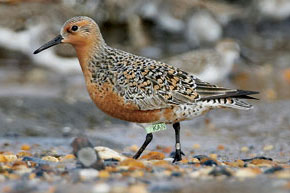Red Knots and Horseshoe Crabs: A Shorebird Phenomenon

Each spring, the Delaware Bay plays host to one of nature's most amazing and bizarre annual rituals: the mass spawning of Horseshoe Crabs. These harmless, but somewhat menacing-looking creatures storm the bay beaches on high tides, burying huge numbers of pinhead-sized eggs in the damp sand. Countless thousands of these morsels wash out, or are dug out by successive cohorts of crabs, turning the beach into a natural caviar buffet. Hordes of famished Red Knots, Ruddy Turnstones, Sanderlings, Semipalmated Sandpipers, and others stop here to replenish their exhausted fat stores before continuing the arduous journey from Latin America to their Arctic breeding grounds.
Birders who wish to experience this spectacle should be aware that its exact character varies from year to year, and depends on a rather complex interplay of Horseshoe Crabs, birds, tides, and weather. A good place to start your visit is the new DuPont Nature Center at Mispillion Reserve at the north end of Slaughter Beach. It's located adjacent to some of the richest spawning and birding beaches.
Port Mahon Road east of Little Creek can also be excellent, as can bayshore areas of Milford Neck, and Prime Hook. Shorebird numbers are usually highest from about May 15 to May 30. Best viewing of shorebirds is often on a falling or rising tide, when tidal flats are not too extensive. Please be extremely cautious of disturbing feeding activity - if the birds retreat or flush, you're too close. Back off, and keep motion to an absolute minimum. If the birds do not soon return, you are still too close. Thank you for following these simple guidelines.











